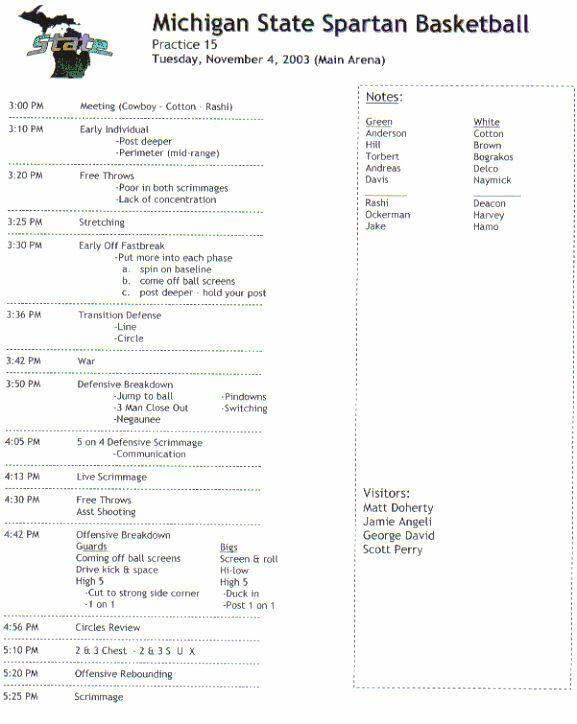  |
Last One Holding The Chalk...Usually Wins!(November 2003)Assortment of plays, drills and ideas to help your program improve.
Chalk Talk - X's and O's Strategy - SYRACUSE BASKETBALL (click plays below) Last week I had the opportunity to visit one of the finest basketball programs and certainly one of the best basketball coaches in the country...Tom Izzo and Michigan State University. I have included their practice plan below. I don't want to spend any time today in going over the practice plan, as I thought seeing what they do in practice, the time devoted to each area and the type of drills used would be just as valuable.
From Tom Nordland and a Conversation for Great Shooting I’ve become more aware recently of how I hold and set the ball and I want to pass on some ideas to you and invite you to check them out with your own shot (and/or those of your players, if you’re a coach). PURPOSE
OF THE OFF HAND* It's not used for providing power to shoot. That truth , though seemingly axiomatic, requires reinforcement. Many shooting flaws that result in directional misses can be traced to the non-shooting hand being in contact with ball at the time of release. This dilutes and diminishes the purity of the shot, which is, at its core, a one-handed shot.” (Note that the “Shooting Pocket” and “Set Point” are the same thing.) POSITION OF
OFF HAND There are different theories, I’m sure, as to why the grip needs to be on the side. One theory I’ve heard is that it gives a stronger grip, another says that grip is closest to a chest pass grip and enables quicker change to move into a shooting grip. In looking at some clips of great shooters I’ve got, I see both ways of gripping the ball. I don’t know which is the “better” grip. I just ask that you examine your own grip (and your players’ grips) and play with them to make sure you have the most effective grip for you. The under-the-ball grip has one advantage I can see: As I lift the ball to the Set Point, my off hand, the left, does ALL of the lifting. Being under the ball it can do that, and the shooting hand, behind behind the ball, cannot help or interfere. When I reach my Set Point, then the shooting hand takes over and does the Release, while the Off hand falls away. The advantage I see is that there’s no need for the shooting hand to adjust its ball position to shoot. It can be on line with the target the entire time and simple “take over” when the ball gets to the Set Position. See if the on-the-side position has that same advantage. Since both hands are needed to bring the ball up, there has to be pressure from both hands holding the ball. When the shooting hand takes over, there would have to be a disconnecting of the Off hand and a re-adjustment, maybe just ever so slight, of the Shooting hand taking over. It’s probably not a problem and maybe both ways work the same. I’d be interested in your exploration of this to see if the side grip approach causes any adjustment before shooting. THE
SETTING STARTS THE ALIGNMENT As
I bring the ball up from the Triple Threat position, it gets in line with my eye
and the basket very early, and I discovered this is a key to control of direction.
As the ball leaves the general Triple Threat position, it can be on line, if you
choose it so. However, if your setting is off line until later in the setting
or until the very last part (as it approaches the Set Point), you will minimize
this powerful I’ve heard of some coaching that advocates receiving the ball in the Set Position, or at least very high, so there is less chance of it being knocked away and you can shoot quicker. Though this can work, I think it could be self-defeating. A high starting point eliminates the longer on-line setting I mentioned above. High setting seems more difficult to get the ball on line to me. Getting the shot off quickly isn’t an advantage if you miss most of your shots. Try it both ways and see what makes sense to you. ONE
LAST THING: SET POINT IS JUST A CHANGE OF DIRECTION But I suggest for most shots that you intend to shoot early and quick (without being rushed), so you can catch all of the leg drive energy, what I call UpForce. In so doing the Set Point is just that Change of Direction, thus eliminating one more possible variable, the stop and start when you freeze the ball there for an instant. So see how you hold the ball, how you bring it to the Set Point, and how you release it. The awareness you develop will help you with however you do things. Awareness always “cures.” |




